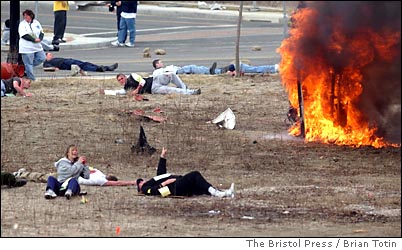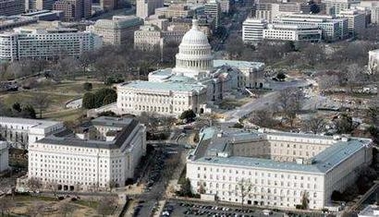Untitled Document

All indications suggest uncomfortable season of fear ahead
Numerous nexus points have emerged that suggest major western governments are
preparing for a summer terror attack that will come close to but not match 9/11
in scale and will provide the justification needed for an air strike on Iran before
the midterm elections in early November.
While there is a danger of becoming the boy who cried wolf, disturbing trends
over the last couple of months do strongly indicate that the twist in the tale,
which is always to be expected in an election year, will be a staged attack
on a major developed city or the soccer World Cup. Here are the red flags.
- An increase in taped
messages from supposed Al-Qaeda figures Osama bin Laden and Musab Al-Zarqawi.
- Terror
arrests in England and Canada that seem to have little purpose other than
making a future attack seem inevitable in the minds of the public.
- A report in the Washington
Post detailing how 4,000 federal government officials will enter shadow
government bunkers on June 19th for a continuity of government drill in anticipation
of a major terrorist attack. Every major terrorist attack is preceded by or
runs parallel to a government drill in order to provide governments with plausible
deniability if they get caught facilitating the attack.
- Martial law evacuation
exercises being conducted in Washington DC under the cover of manufactured
crises.

- A nationwide FEMA
program teaching Pastors and other neighborhood volunteers to inculcate
the inevitability of martial law in America to their communities and urging
them not to resist when it happens, a procedure set to be completed at the end
of August.
- A report from CBS
News quoting anonymous US government officials who say that they would be
surprised if an attack didn't happen before the end of the year, albeit on a
smaller scale than 9/11.
- Sagging presidential approval
numbers that have dipped into the twenties for the first time.
- A GOP
memo that touts a devastating attack by terrorists on US soil as a way of
keeping the Republican party from losing control of Congress in the 2006 midterm
elections and restoring Bush's image as a war leader.
- The need for a pretext to launch an air strike on Iran's alleged nuclear
processing facilities, an eventuality scheduled for later
this month or in July, according to former CIA analyst Ray McGovern.
- Israel's fundamentalist
insistence that such an attack be launched as soon as possible.

- A pretext that could be created by means of a false flag attack on the World
Cup in Germany, blamed on Hizbullah and by proxy Iran. Israel have sent out
veiled
threats that this could happen and Iranian President Mahmoud Ahmadinejad's
decision to travel to Germany if his country reaches the second round of the
tournament is more likely to be based around his desire to offset the potential
attack than his love of soccer.
Any future terror attack does not even have to lead back to Iran in order to
rally enough support to attack an innocent country as we saw with Iraq. About
half of Americans see the world as divided between good guys and bad guys. There
really is no need for the shadow government to become more sophisticated in
their methods but this might prove their downfall at a later date.
When considered in a nexus, these indications all unfortunately illustrate
a desperate drive towards preparing western populations for another attack this
summer.
_________________________
BACK TO THE BUNKER
By William M. Arkin
The
Washington Post
Sunday, June 4, 2006; B01
On Monday, June 19, about 4,000 government workers representing more
than 50 federal agencies from the State Department to the Commodity Futures
Trading Commission will say goodbye to their families and set off for dozens
of classified emergency facilities stretching from the Maryland and Virginia
suburbs to the foothills of the Alleghenies. They will take to the bunkers in
an "evacuation" that my sources describe as the largest "continuity
of government" exercise ever conducted, a drill intended to prepare the
U.S. government for an event even more catastrophic than the Sept. 11, 2001,
attacks.
The exercise is the latest manifestation of an obsession with government survival
that has been a hallmark of the Bush administration since 9/11, a focus of enormous
and often absurd time, money and effort that has come to echo the worst follies
of the Cold War. The vast secret operation has updated the duck-and-cover scenarios
of the 1950s with state-of-the-art technology -- alerts and updates delivered
by pager and PDA, wireless priority service, video teleconferencing, remote
backups -- to ensure that "essential" government functions continue
undisrupted should a terrorist's nuclear bomb go off in downtown Washington.
But for all the BlackBerry culture, the outcome is still old-fashioned black
and white: We've spent hundreds of millions of dollars on alternate facilities,
data warehouses and communications, yet no one can really foretell what would
happen to the leadership and functioning of the federal government in a catastrophe.
After 9/11, The Washington Post reported that President Bush had set up a shadow
government of about 100 senior civilian managers to live and work outside Washington
on a rotating basis to ensure the continuity of national security. Since then,
a program once focused on presidential succession and civilian control of U.S.
nuclear weapons has been expanded to encompass the entire government. From the
Department of Education to the Small Business Administration to the National
Archives, every department and agency is now required to plan for continuity
outside Washington.
Yet according to scores of documents I've obtained and interviews with half
a dozen sources, there's no greater confidence today that essential services
would be maintained in a disaster. And no one really knows how an evacuation
would even be physically possible.
Moreover, since 9/11 and Hurricane Katrina, the definition of what constitutes
an "essential" government function has been expanded so ridiculously
beyond core national security functions -- do we really need patent and trademark
processing in the middle of a nuclear holocaust? -- that the term has become
meaningless. The intent of the government effort may be laudable, even necessary,
but a hyper-centralized approach based on the Cold War model of evacuations
and bunkering makes it practically worthless.
That the continuity program is so poorly conceived, and poorly run, should
come as no surprise. That's because the same Federal Emergency Management Agency
that failed New Orleans after Katrina, an agency that a Senate investigating
committee has pronounced "in shambles and beyond repair," is in charge
of this enormous effort to plan for the U.S. government's survival.
Continuity programs began in the early 1950s, when the threat of nuclear war
moved the administration of President Harry S. Truman to begin planning for
emergency government functions and civil defense. Evacuation bunkers were built,
and an incredibly complex and secretive shadow government program was created.
At its height, the grand era of continuity boasted the fully operational Mount
Weather, a civilian bunker built along the crest of Virginia's Blue Ridge, to
which most agency heads would evacuate; the Greenbrier hotel complex and bunker
in West Virginia, where Congress would shelter; and Raven Rock, or Site R, a
national security bunker bored into granite along the Pennsylvania-Maryland
border near Camp David, where the Joint Chiefs of Staff would command a protracted
nuclear war. Special communications networks were built, and evacuation and
succession procedures were practiced continually.
When the Soviet Union crumbled, the program became a Cold War curiosity: Then-Defense
Secretary Dick Cheney ordered Raven Rock into caretaker status in 1991. The
Greenbrier bunker was shuttered and a 30-year-old special access program was
declassified three years later.
Then came the terrorist attacks of the mid-1990s and the looming Y2K rollover,
and suddenly continuity wasn't only for nuclear war anymore. On Oct. 21, 1998,
President Bill Clinton signed Presidential Decision Directive 67, "Enduring
Constitutional Government and Continuity of Government Operations." No
longer would only the very few elite leaders responsible for national security
be covered. Instead, every single government department and agency was directed
to see to it that they could resume critical functions within 12 hours of a
warning, and keep their operations running at emergency facilities for up to
30 days. FEMA was put in charge of this broad new program.
On 9/11, the program was put to the test -- and failed. Not on the national
security side: Vice President Cheney and others in the national security leadership
were smoothly whisked away from the capital following procedures overseen by
the Pentagon and the White House Military Office. But like the mass of Washingtonians,
officials from other agencies found themselves virtually on their own, unsure
of where to go or what to do, or whom to contact for the answers.
In the aftermath, the federal government was told to reinvigorate its continuity
efforts. Bush approved lines of succession for civil agencies. Cabinet departments
and agencies were assigned specific emergency responsibilities. FEMA issued
new preparedness guidelines and oversaw training. A National Capital Region
continuity working group established in 1999, comprising six White House groups,
15 departments and 61 agencies, met to coordinate.
But all the frenetic activity did not produce a government prepared for the
worst. A year after 9/11, and almost three years after the deadline set in Clinton's
1998 directive, the Government Accounting Office evaluated 38 agencies and found
that not one had addressed all the issues it had been ordered to. A 2004 GAO
audit of 34 government continuity-of-operations plans found total confusion
on the question of essential functions. One unnamed organization listed 399
such functions. A department included providing "speeches and articles
for the Secretary and Deputy Secretary" among its essential duties, while
neglecting many of its central programs.
The confusion and absurdity have continued, according to documents I've collected
over the past few years. In June 2004, FEMA told federal agencies that essential
services in a catastrophe would include not only such obvious ones as electric
power generation and disaster relief but also patent and trademark processing,
student aid and passport processing. A month earlier, FEMA had told states and
local communities that library services should be counted as essential along
with fire protection and law enforcement.
None of this can be heartening to Americans who want to believe that in a crisis,
their government can distinguish between what is truly essential and what isn't
-- and provide it.
Just two years ago, an exercise called Forward Challenge '04 pointed up the
danger of making everyone and everything essential: Barely an hour after agencies
were due to arrive at their relocation sites, the Office of Management and Budget
asked the reconstituted government to identify emergency funding requirements.
As one after-action report for the exercise later put it in a classic case
of understatement: "It was not clear . . . whether this would be a realistic
request at that stage of an emergency."
This year's exercise, Forward Challenge '06, will be the third major interagency
continuity exercise since 9/11. Larger than Forward Challenge '04 and the Pinnacle
exercise held last year, it requires 31 departments and agencies (including
FEMA) to relocate. Fifty to 60 are expected to take part.
According to government sources, the exercise will test the newly created continuity
of government alert conditions -- called COGCONs -- that emulate the DEFCONs
of the national security community. Forward Challenge will begin with a series
of alerts via BlackBerry and pager to key officials. It will test COGCON 1,
the highest level of preparedness, in which each department and agency is required
to have at least one person in its chain of command and sufficient staffing
at alternate operating facilities to perform essential functions.
Though key White House officials and military leadership would be relocated
via the Pentagon's Joint Emergency Evacuation Program (JEEP), the civilians
are on their own to make it to their designated evacuation points.
But fear not: Each organization's COOP, or continuity of operations plan, details
the best routes to the emergency locations. The plans even spell out what evacuees
should take with them (recommended items: a combination lock, a flashlight,
two towels and a small box of washing powder).
Can such an exercise, announced well in advance, hope to re-create any of the
tensions and fears of a real crisis? How do you simulate the experience of driving
through blazing, radiated, panic-stricken streets to emergency bunker sites
miles away?
As the Energy Department stated in its review of Forward Challenge '04, "a
method needs to be devised to realistically test the ability of . . . federal
offices to relocate to their COOP sites using a scenario that simulates . .
. the monumental challenges that would be involved in evacuating the city."
With its new plans and procedures, Washington may think it has thought of everything
to save itself. Forward Challenge will no doubt be deemed a success, and officials
will pronounce the continuity-of-government project sound. There will be lessons
to be learned that will justify more millions of dollars and more work in the
infinite effort to guarantee order out of chaos.
But the main defect -- a bunker mentality that considers too many people and
too many jobs "essential" -- will remain unchallenged.
warkin@igc.org
William M. Arkin writes the Early Warning blog for washingtonpost.com
and is the author of "Code Names: Deciphering U.S. Military Plans, Programs
and Operations in the 9/11 World" (Steerforth Press).

